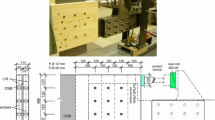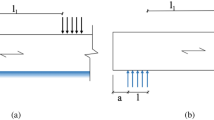Abstract
Two different dowel-type joints of differing size were loaded in tension parallel to the grain. The strain distribution in the joint area was studied using a contact-free measurement system. The results were compared with those of numerical analysis. The measurement system was found to be a valuable complement to traditional measurement techniques and also to numerical analyses performed in parametric studies. The measurements obtained were shown to be particularly useful for studying the highly nonlinear behavior of timber that is of special importance in characterizing timber dowel joints.
Several observations of considerable interest were made on the basis of numerical results in combination with results of the contact-free measurement system. A non-uniform strain distribution in the joint area was detected, for example, and shear strains and tensile strains, both parallel and perpendicular to the grain were found to be concentrated in the areas most likely to influence the failure mode of the joint. A general observation made was that the larger size joint failed in brittle manner, an observation supported by previous research.
Zusammenfassung
Zwei verschiedene Stabdübelverbindungen unterschiedlicher Grösse wurden auf Zug in Faserrichtung belastet. Die Dehnungsverteilung im Bereich der Verbindung wurde mittels eines berührungslosen Messsystems untersucht und mit den Ergebnissen aus einer numerischen Analyse verglichen. Das Messsystem erwies sich als wertvolle Ergänzung zu herkömmlichen Messtechniken sowie zu den Ergebnissen von Parameterstudien. Die Messungen erwiesen sich als besonders hilfreich zur Untersuchung des stark nicht-linearen Verhaltens von Holz, das für die Charakterisierung von Holzdübelverbindungen grosse Bedeutung hat.
Die numerischen Ergebnisse führten zusammen mit den berührungslosen Messungen zu einigen interessanten Erkenntnissen. So wurde zum Beispiel eine ungleichmässige Dehnungsverteilung im Verbindungsbereich festgestellt. Darüber hinaus fand man heraus, dass Schubdehnungen und Zugdehnungen parallel und senkrecht zur Faser konzentriert in den für den Bruch massgebenden Bereichen vorkamen. Generell wurde in Übereinstimmung mit früheren Untersuchungen festgestellt, dass bei den grösseren Verbindungen ein Sprödbruch auftrat.
Similar content being viewed by others
References
ABAQUS Inc. (2003) ABAQUS/Standard and ABAQUS/CAE Version 6.4, User Manuals
Cramer CO (1968) Load distribution in multiple-bolt tension joints. J Struct Div ASCE 94:1101–1117
CSA O86.1. (2001) Engineering design in wood (Limits States Design). Can Stand Assoc
Eurocode 5 (2004) Design of timber structures. EN 1995-1-1:2004(E)
Johansen KW (1949) Theory of timber connections. Int Assoc Bridge Struct Eng 9:249–262
Jorissen A (1998) Double shear timber connections with dowel type fasteners. Ph.D. thesis, Delft University, Delft, The Netherlands
Lantos G (1969) Load distribution in a row of fasteners subjected to lateral load. Wood Sci 1(3):129–136
Masuda M, Tabata K (2001) Theoretical and experimental analyses of fracture of wood in pinned joint using DIC and FSAFC (Finite Small Area Fracture Criterion). Proc Int RILEM Symp, Stuttgart, Germany
Pedersen MU, Clorius CO, Damkilde L, Hoffmeyer P, Eskildsen L (1999) Dowel type connections with slotted-in steel plates. Proc CIB W18 Meeting, paper CIB-W18/32-7-8
Quenneville JHP, Mohammad M (2000) On the failure modes and strength of steel-to-timber bolted connections loaded parallel-to-grain. Can J Eng 27:761–773
Ranta-Maunus A, Kevarinmäki A (2003) Reliability of timber structures theory and dowel-type connection failures. Proc CIB W18 Meeting, paper CIB-W18/36-17-1, Colorado, USA
Rodd PD (1973) The analysis of timber joints made with circular dowel connectors. Ph.D. thesis, University of Sussex, England
Schmid M, Blass HJ, Frasson RPM (2002) Effect of distances, spacing and number of dowels in a row on the load carrying capacity of connections with dowels failing by splitting. Proc CIB W18 Meeting, paper CIB-W18/31-9-1, Kyoto, Japan
Wilkinson TL (1986) Load distribution among bolts parallel to load. J Struct Eng ASCE 112(4):835–852
Author information
Authors and Affiliations
Corresponding author
Rights and permissions
About this article
Cite this article
Sjödin, J., Enquist, B. & Serrano, E. Contact-free measurements and numerical analyses of the strain distribution in the joint area of steel-to-timber dowel joints. Holz Roh Werkst 64, 497–506 (2006). https://doi.org/10.1007/s00107-006-0112-1
Published:
Issue Date:
DOI: https://doi.org/10.1007/s00107-006-0112-1




